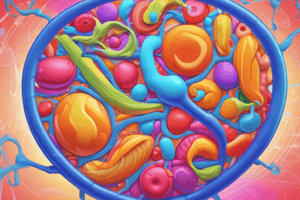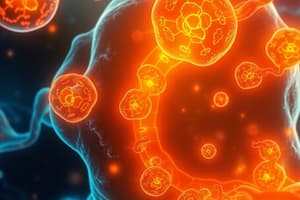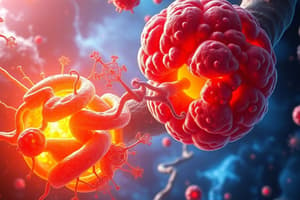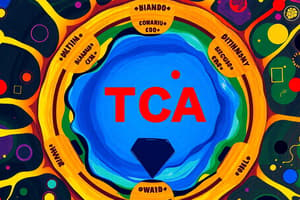Podcast
Questions and Answers
Why is the inner mitochondrial membrane less permeable compared to the outer membrane?
Why is the inner mitochondrial membrane less permeable compared to the outer membrane?
- To facilitate the diffusion of CO2 out of the matrix.
- To maintain the electrochemical gradient necessary for ATP synthesis. (correct)
- To prevent the entry of pyruvate into the mitochondrial matrix.
- To allow for easier passage of acetyl-CoA into the intermembrane space.
What is the primary reason the TCA cycle is referred to as a 'cycle'?
What is the primary reason the TCA cycle is referred to as a 'cycle'?
- The enzymes involved are recycled after each reaction.
- It requires continuous input of ATP to function.
- It involves a series of reactions that occur in a circular pattern within the mitochondrial matrix.
- The final product is identical to the initial substrate, allowing the process to repeat. (correct)
What is the immediate fate of acetyl-CoA when it enters the TCA cycle?
What is the immediate fate of acetyl-CoA when it enters the TCA cycle?
- It binds to the inner mitochondrial membrane.
- It is directly converted into ATP.
- It is transported to the intermembrane space for further processing.
- The coenzyme A (CoA) component is removed, leaving acetyl. (correct)
For each molecule of acetyl that enters the TCA cycle, how many molecules of $CO_2$ are produced?
For each molecule of acetyl that enters the TCA cycle, how many molecules of $CO_2$ are produced?
What determines whether FAD is reduced to $FADH_2$ instead of NADH during the TCA cycle?
What determines whether FAD is reduced to $FADH_2$ instead of NADH during the TCA cycle?
During substrate-level phosphorylation in the TCA cycle, what molecule directly donates a phosphate group to ADP to form ATP?
During substrate-level phosphorylation in the TCA cycle, what molecule directly donates a phosphate group to ADP to form ATP?
If the electron transport chain (ETC) ceases to function due to a lack of oxygen, what immediate effect does this have on the TCA cycle?
If the electron transport chain (ETC) ceases to function due to a lack of oxygen, what immediate effect does this have on the TCA cycle?
In what cellular compartment does the conversion of pyruvate to acetyl-CoA occur?
In what cellular compartment does the conversion of pyruvate to acetyl-CoA occur?
What are the direct products of the conversion of pyruvate to acetyl-CoA?
What are the direct products of the conversion of pyruvate to acetyl-CoA?
Translocators of the inner membrane are known as:
Translocators of the inner membrane are known as:
What happens to the carbons from acetyl as it goes through the cycle?
What happens to the carbons from acetyl as it goes through the cycle?
What is the total amount of ATP produced by the end of the TCA cycle?
What is the total amount of ATP produced by the end of the TCA cycle?
Which molecule is the main factor of the TCA cycle?
Which molecule is the main factor of the TCA cycle?
What is another name for NADH and $FADH_2$?
What is another name for NADH and $FADH_2$?
Where are TOMs translocators located?
Where are TOMs translocators located?
Flashcards
Intermembrane Space
Intermembrane Space
The space between the inner and outer mitochondrial membranes.
Mitochondrial Matrix
Mitochondrial Matrix
The space enclosed by the inner mitochondrial membrane.
TOMs
TOMs
Translocators on the mitochondrial outer membrane that are less specific.
TIMs
TIMs
Signup and view all the flashcards
Acetyl CoA in TCA Cycle
Acetyl CoA in TCA Cycle
Signup and view all the flashcards
NADH and FADH2
NADH and FADH2
Signup and view all the flashcards
NAD+ and FAD
NAD+ and FAD
Signup and view all the flashcards
Substrate-Level Phosphorylation
Substrate-Level Phosphorylation
Signup and view all the flashcards
Oxidative Phosphorylation
Oxidative Phosphorylation
Signup and view all the flashcards
Total ATP Yield
Total ATP Yield
Signup and view all the flashcards
Pyruvate to Acetyl CoA
Pyruvate to Acetyl CoA
Signup and view all the flashcards
Study Notes
- Mitochondria possess two membranes, with the intermembrane space located between them
- The matrix refers to the space enclosed by the inner membrane
- The outer mitochondrial membrane exhibits greater permeability compared to the inner membrane
- TOMs, found on the outer membrane, act as less specific translocators
- TIMs are translocators located on the inner membrane
TCA Cycle Characteristics
- The TCA cycle is named as such because the final product is identical to the initial substrate
- Acetyl coA serves as the primary component of the TCA cycle
- Upon entering the cycle, coA is removed, leaving only acetyl
- As acetyl progresses through the cycle, it loses its carbon in the form of CO2
- Because acetyl consists of two carbon atoms, two CO2 molecules are produced per cycle
Products of the TCA Cycle
- Three NADH molecules are generated during substrate conversion
- In instances where energy release between conversions is insufficient, FAD is reduced to FADH2
- NADH and FADH2 are classified as reduced coenzymes
- ATP is generated via substrate-level phosphorylation, but most ATP is produced during oxidative phosphorylation
- GDP is converted to GTP, subsequently donating a phosphate group to ADP, resulting in the production of one ATP molecule per cycle
ATP Production
- A total of 38 ATP molecules are produced
Impact of Oxygen Absence
- In the absence of O2, the electron transport chain (ETC) ceases to function, leading to an accumulation of FADH2 and NADH, as well as a deficiency of NAD and FAD
- Consequently, the Krebs cycle also halts its operation
Pyruvate Conversion
- Pyruvate undergoes conversion to Acetyl coA within the mitochondria
- This specific step is not considered part of the TCA cycle
- This conversion process yields CO2 and NADH
Studying That Suits You
Use AI to generate personalized quizzes and flashcards to suit your learning preferences.




